TOYOTA PRIUS C 2013 NHP10 / 1.G Owners Manual
Manufacturer: TOYOTA, Model Year: 2013, Model line: PRIUS C, Model: TOYOTA PRIUS C 2013 NHP10 / 1.GPages: 556, PDF Size: 8.88 MB
Page 471 of 556
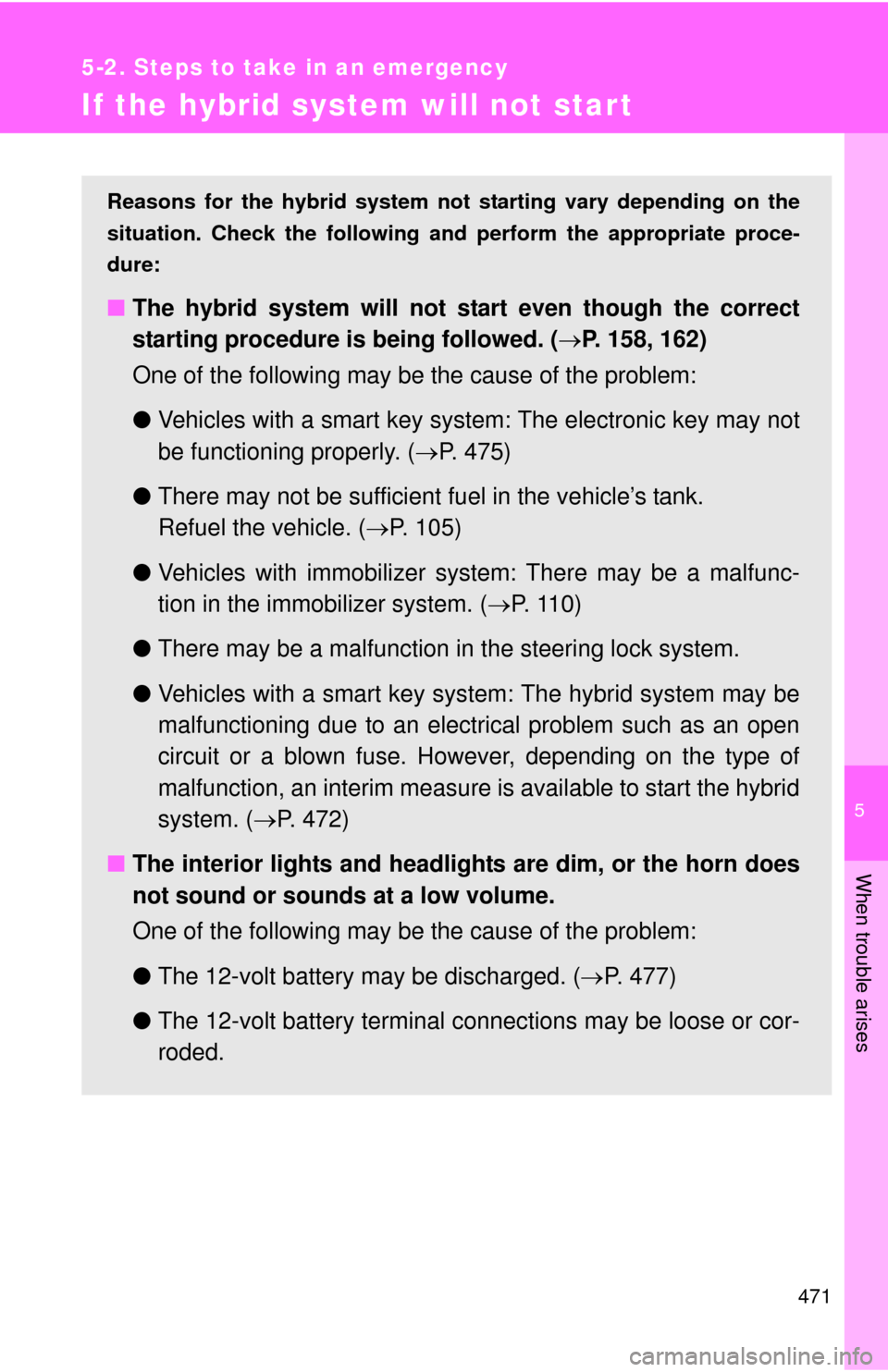
5
When trouble arises
471
5-2. Steps to take in an emergency
If the hybrid system will not start
Reasons for the hybrid system not starting vary depending on the
situation. Check the following and perform the appropriate proce-
dure:
■ The hybrid system will not start even though the correct
starting procedure is being followed. ( P. 158, 162)
One of the following may be the cause of the problem:
● Vehicles with a smart key system: The electronic key may not
be functioning properly. ( P. 475)
● There may not be sufficient fuel in the vehicle’s tank.
Refuel the vehicle. ( P. 105)
● Vehicles with immobilizer sy stem: There may be a malfunc-
tion in the immobilizer system. ( P. 1 1 0 )
● There may be a malfunction in the steering lock system.
● Vehicles with a smart key syst em: The hybrid system may be
malfunctioning due to an electrical problem such as an open
circuit or a blown fuse. However, depending on the type of
malfunction, an interim measure is available to start the hybrid
system. ( P. 472)
■ The interior lights and headlights are dim, or the horn does
not sound or sounds at a low volume.
One of the following may be the cause of the problem:
●The 12-volt battery may be discharged. ( P. 477)
● The 12-volt battery terminal c onnections may be loose or cor-
roded.
Page 472 of 556
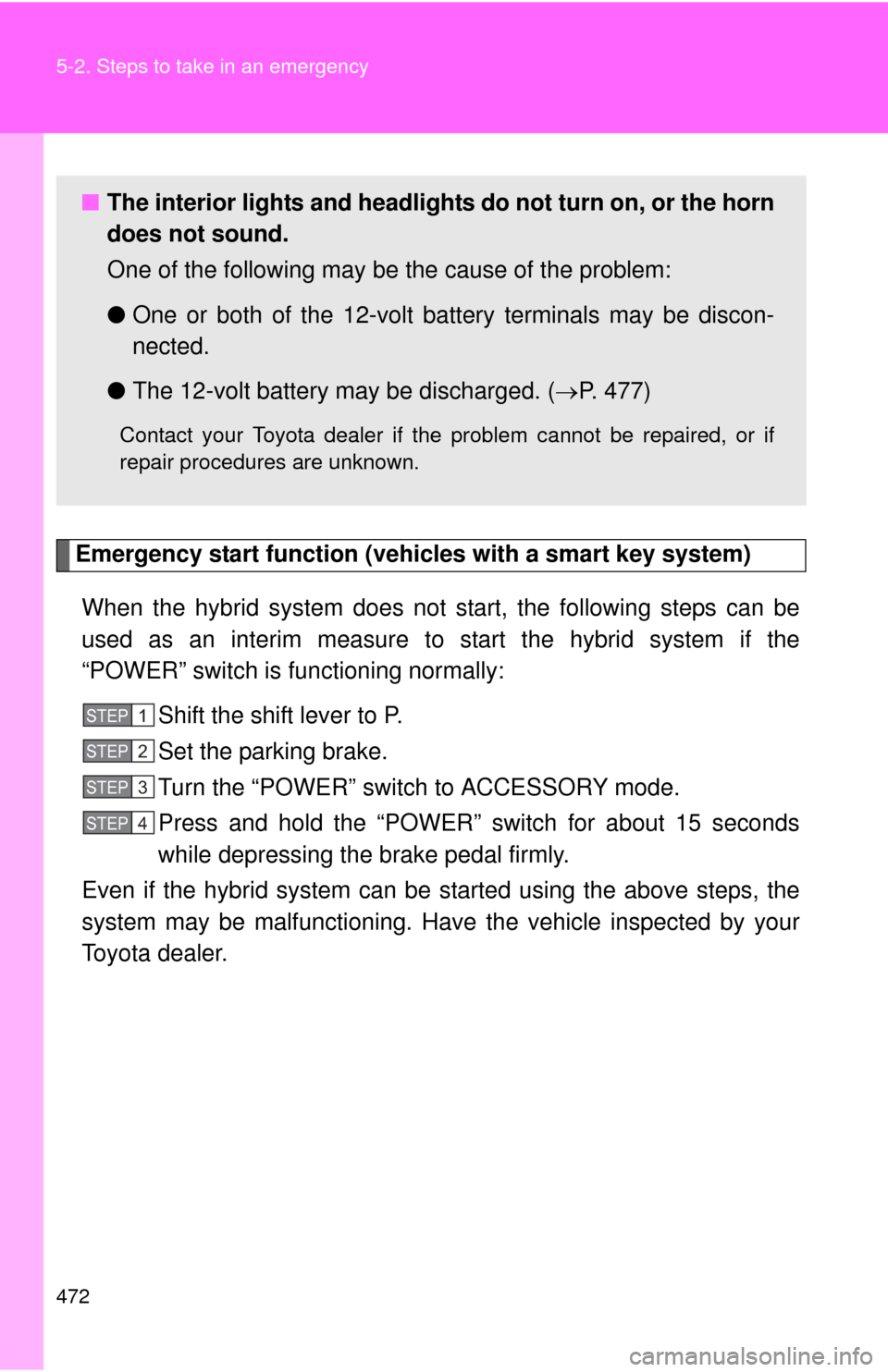
472 5-2. Steps to take in an emergency
Emergency start function (vehicles with a smart key system)When the hybrid system does not start, the following steps can be
used as an interim measure to start the hybrid system if the
“POWER” switch is functioning normally: Shift the shift lever to P.
Set the parking brake.
Turn the “POWER” switch to ACCESSORY mode.
Press and hold the “POWER” switch for about 15 seconds
while depressing the brake pedal firmly.
Even if the hybrid system can be started using the above steps, the
system may be malfunctioning. Have the vehicle inspected by your
Toyota dealer.
■ The interior lights and headlights do not turn on, or the horn
does not sound.
One of the following may be the cause of the problem:
●One or both of the 12-volt ba ttery terminals may be discon-
nected.
● The 12-volt battery may be discharged. ( P. 477)
Contact your Toyota dealer if the problem cannot be repaired, or if
repair procedures are unknown.
STEP1
STEP2
STEP3
STEP4
Page 473 of 556
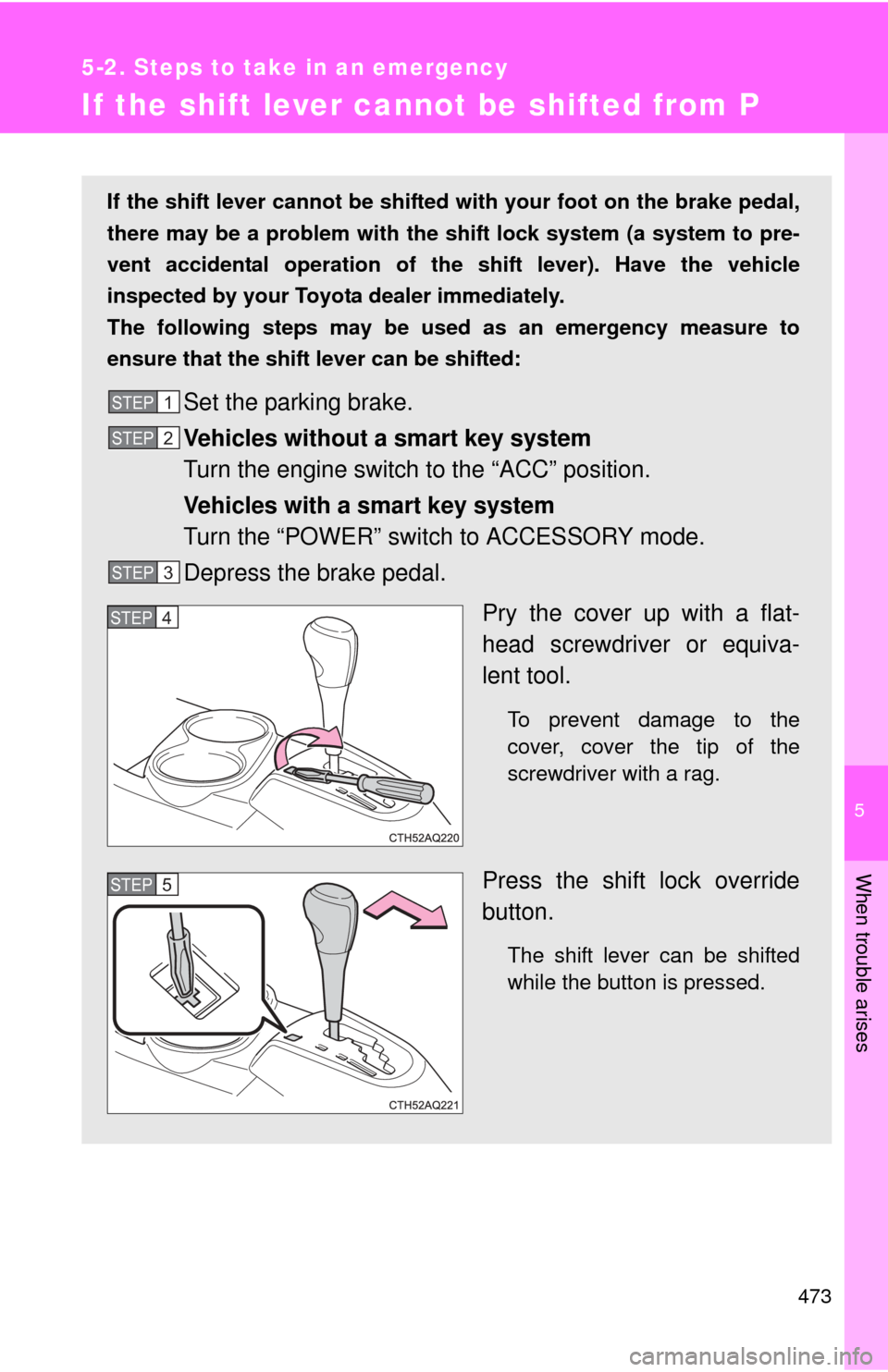
5
When trouble arises
473
5-2. Steps to take in an emergency
If the shift lever cannot be shifted from P
If the shift lever cannot be shifted with your foot on the brake pedal,
there may be a problem with the shift lock system (a system to pre-
vent accidental operation of the shift lever). Have the vehicle
inspected by your Toyo ta dealer immediately.
The following steps may be used as an emergency measure to
ensure that the shift lever can be shifted:
Set the parking brake.
Vehicles without a smart key system
Turn the engine switch to the “ACC” position.
Vehicles with a smart key system
Turn the “POWER” switch to ACCESSORY mode.
Depress the brake pedal.
Pry the cover up with a flat-
head screwdriver or equiva-
lent tool.
To prevent damage to the
cover, cover the tip of the
screwdriver with a rag.
Press the shift lock override
button.
The shift lever can be shifted
while the button is pressed.
STEP1
STEP2
STEP3
STEP4
STEP5
Page 474 of 556
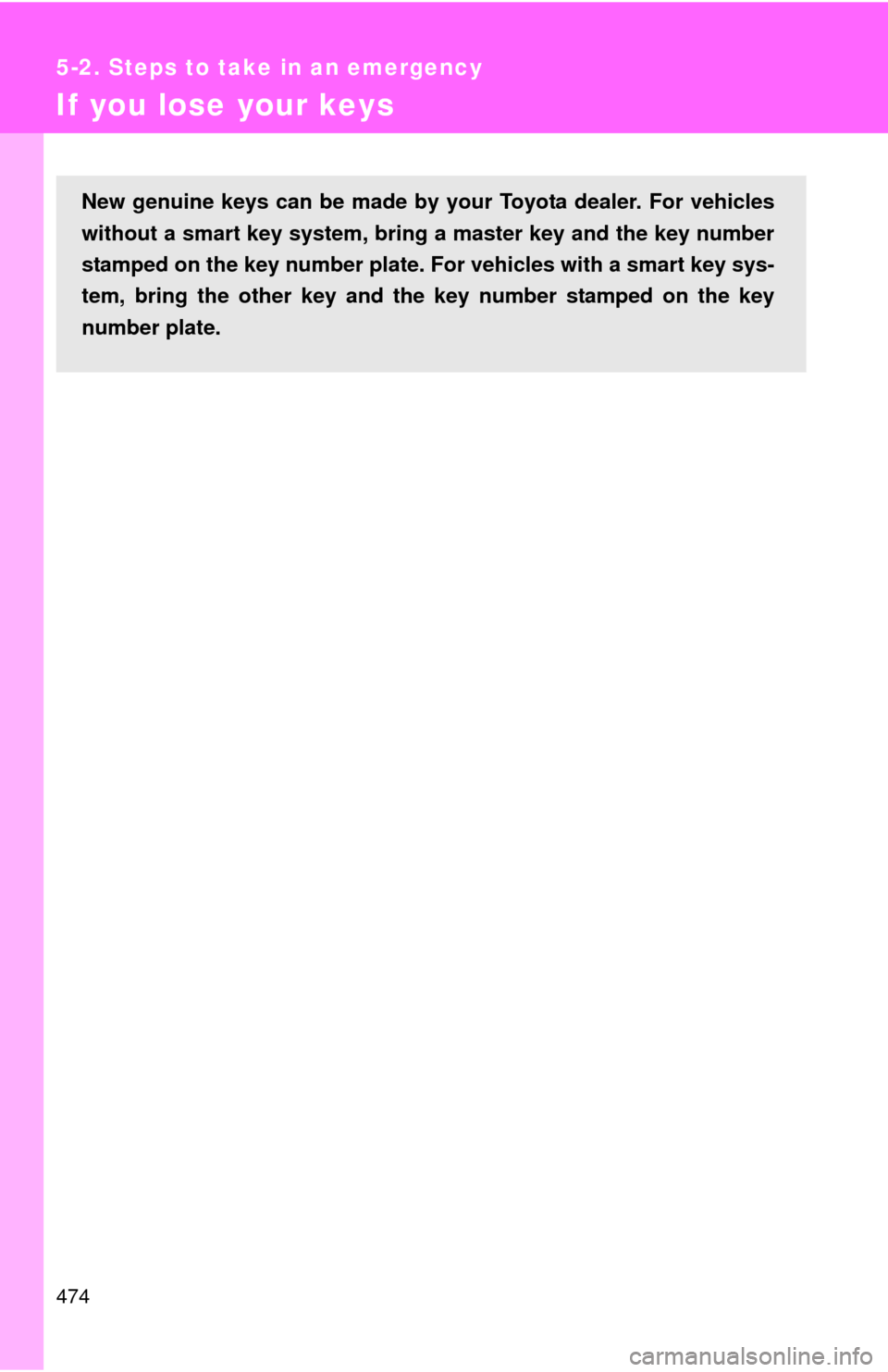
474
5-2. Steps to take in an emergency
If you lose your keys
New genuine keys can be made by your Toyota dealer. For vehicles
without a smart key system, bring a master key and the key number
stamped on the key number plate. For vehicles with a smart key sys-
tem, bring the other key and th e key number stamped on the key
number plate.
Page 475 of 556
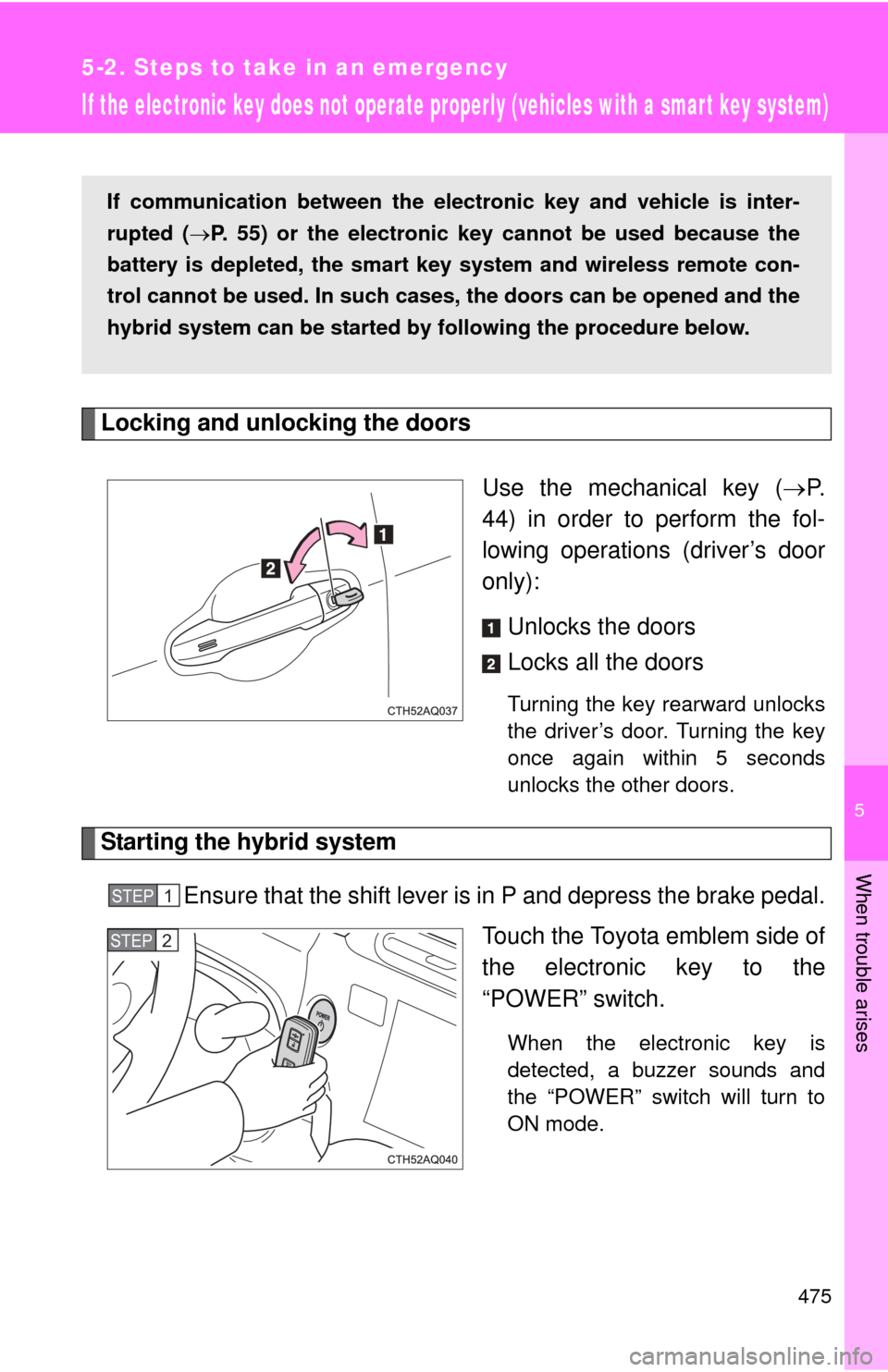
5
When trouble arises
475
5-2. Steps to take in an emergency
If the electronic key does not operate properly (vehicles with a smart key system)
Locking and unlocking the doorsUse the mechanical key (P.
44) in order to perform the fol-
lowing operations (driver’s door
only):
Unlocks the doors
Locks all the doors
Turning the key rearward unlocks
the driver’s door. Turning the key
once again within 5 seconds
unlocks the other doors.
Starting the hybrid system
Ensure that the shift lever is in P and depress the brake pedal. Touch the Toyota emblem side of
the electronic key to the
“POWER” switch.
When the electronic key is
detected, a buzzer sounds and
the “POWER” switch will turn to
ON mode.
If communication between the electronic key and vehicle is inter-
rupted (P. 55) or the electronic key cannot be used because the
battery is depleted, the smart key system and wireless remote con-
trol cannot be used. In such cases, the doors can be opened and the
hybrid system can be started by following the procedure below.
STEP1
STEP2
Page 476 of 556
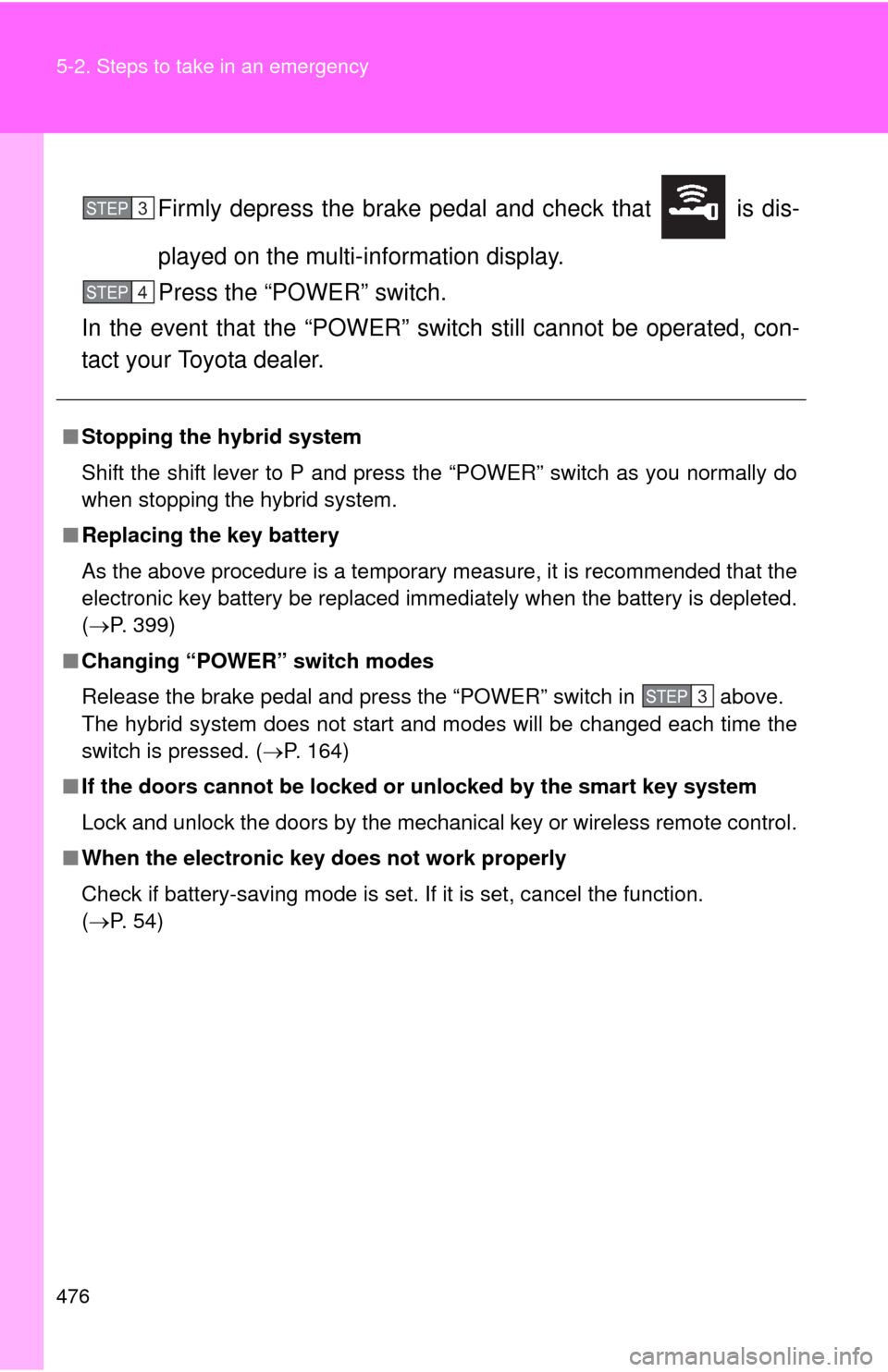
476 5-2. Steps to take in an emergency
Firmly depress the brake pedal and check that is dis-
played on the multi-information display.
Press the “POWER” switch.
In the event that the “POWER” swit ch still cannot be operated, con-
tact your Toyota dealer.
■ Stopping the hybrid system
Shift the shift lever to P and press the “POWER” switch as you normally do
when stopping the hybrid system.
■ Replacing the key battery
As the above procedure is a temporary measure, it is recommended that the
electronic key battery be replaced immediately when the battery is depleted.
(P. 399)
■ Changing “POWER” switch modes
Release the brake pedal and press the “POWER” switch in above.
The hybrid system does not start and modes will be changed each time the
switch is pressed. ( P. 164)
■ If the doors cannot be locked or unlocked by the smart key system
Lock and unlock the doors by the mechanical key or wireless remote contr\
ol.
■ When the electronic key does not work properly
Check if battery-saving mode is set. If it is set, cancel the function.
(P. 54)
STEP3
STEP4
STEP3
Page 477 of 556
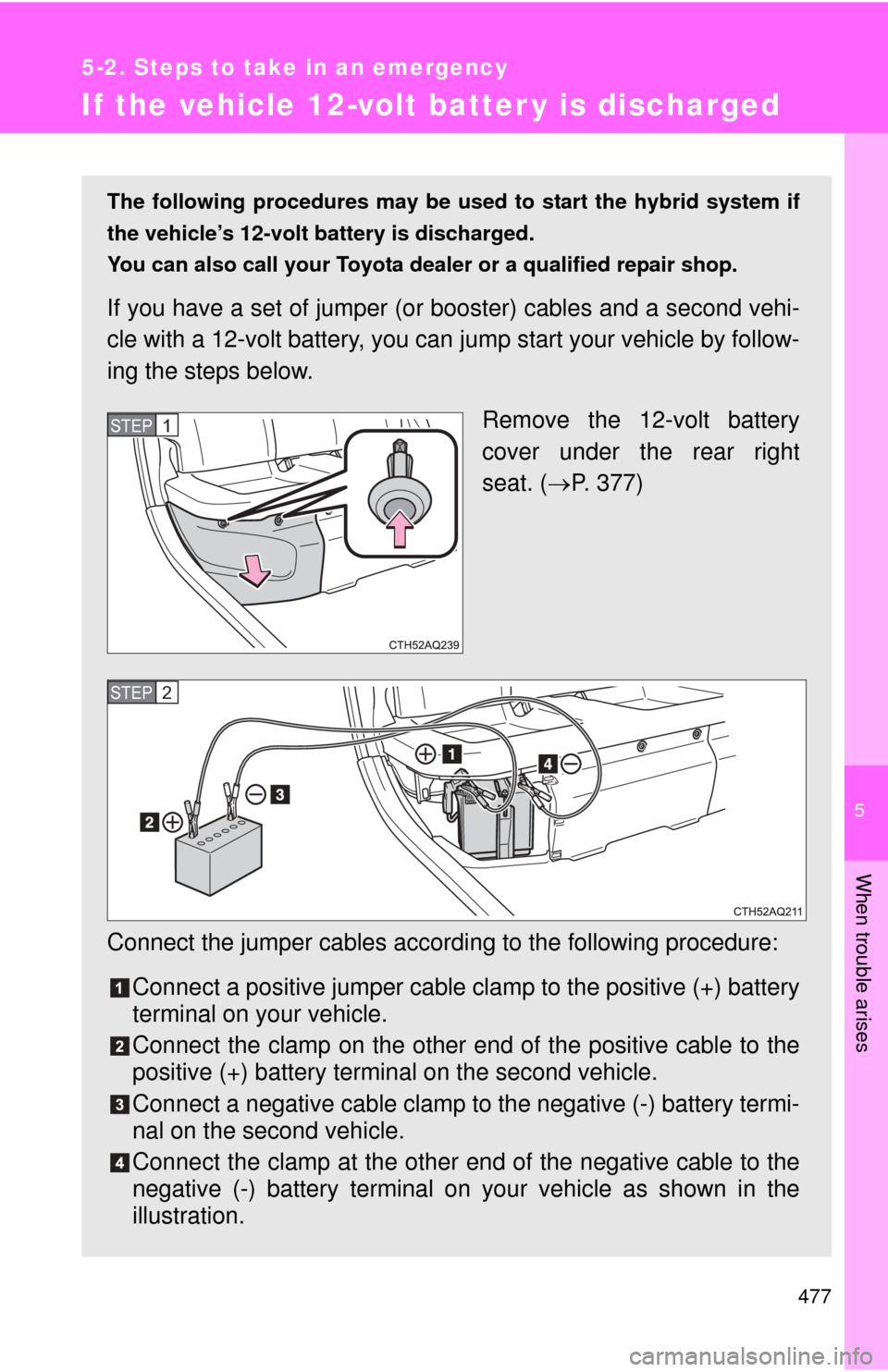
5
When trouble arises
477
5-2. Steps to take in an emergency
If the vehicle 12-volt batter y is discharged
The following procedures may be used to start the hybrid system if
the vehicle’s 12-volt battery is discharged.
You can also call your Toyota deal er or a qualified repair shop.
If you have a set of jumper (or booster) cables and a second vehi-
cle with a 12-volt battery, you can jump start your vehicle by follow-
ing the steps below.
Remove the 12-volt battery
cover under the rear right
seat. (P. 377)
Connect the jumper cables accord ing to the following procedure:
Connect a positive jumper cable clamp to the positive (+) battery
terminal on your vehicle.
Connect the clamp on the other e nd of the positive cable to the
positive (+) battery termin al on the second vehicle.
Connect a negative cable clamp to the negative (-) battery termi-
nal on the second vehicle.
Connect the clamp at the other en d of the negative cable to the
negative (-) battery terminal on your vehicle as shown in the
illustration.
STEP1
STEP2
Page 478 of 556
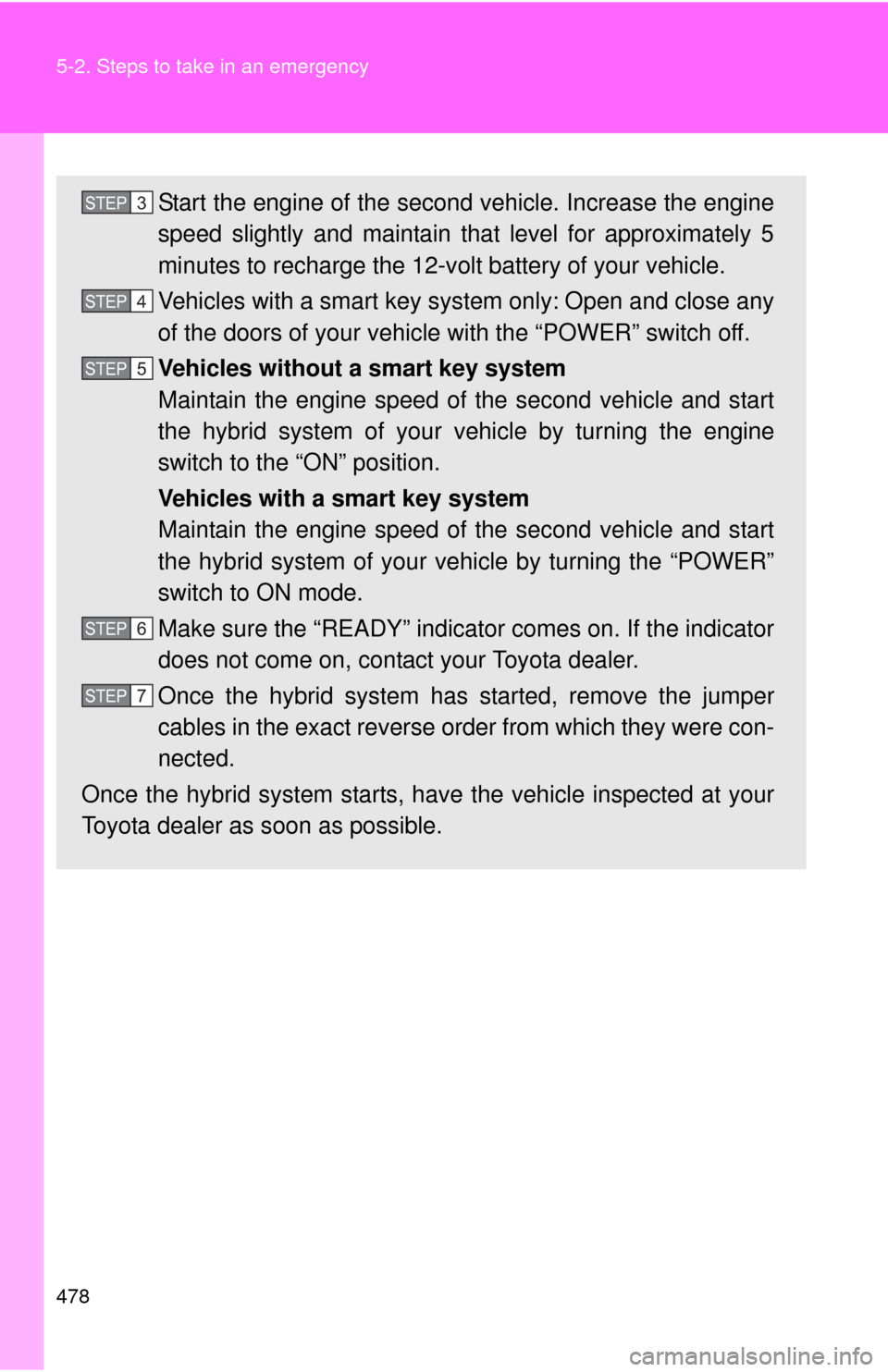
478 5-2. Steps to take in an emergency
Start the engine of the second vehicle. Increase the engine
speed slightly and maintain that level for approximately 5
minutes to recharge the 12-volt battery of your vehicle.
Vehicles with a smart key system only: Open and close any
of the doors of your vehicle with the “POWER” switch off.
Vehicles without a smart key system
Maintain the engine speed of the second vehicle and start
the hybrid system of your vehicle by turning the engine
switch to the “ON” position.
Vehicles with a smart key system
Maintain the engine speed of the second vehicle and start
the hybrid system of your ve hicle by turning the “POWER”
switch to ON mode.
Make sure the “READY” indicator comes on. If the indicator
does not come on, contact your Toyota dealer.
Once the hybrid system has started, remove the jumper
cables in the exact reverse or der from which they were con-
nected.
Once the hybrid system starts, ha ve the vehicle inspected at your
Toyota dealer as soon as possible.STEP3
STEP4
STEP5
STEP6
STEP7
Page 479 of 556
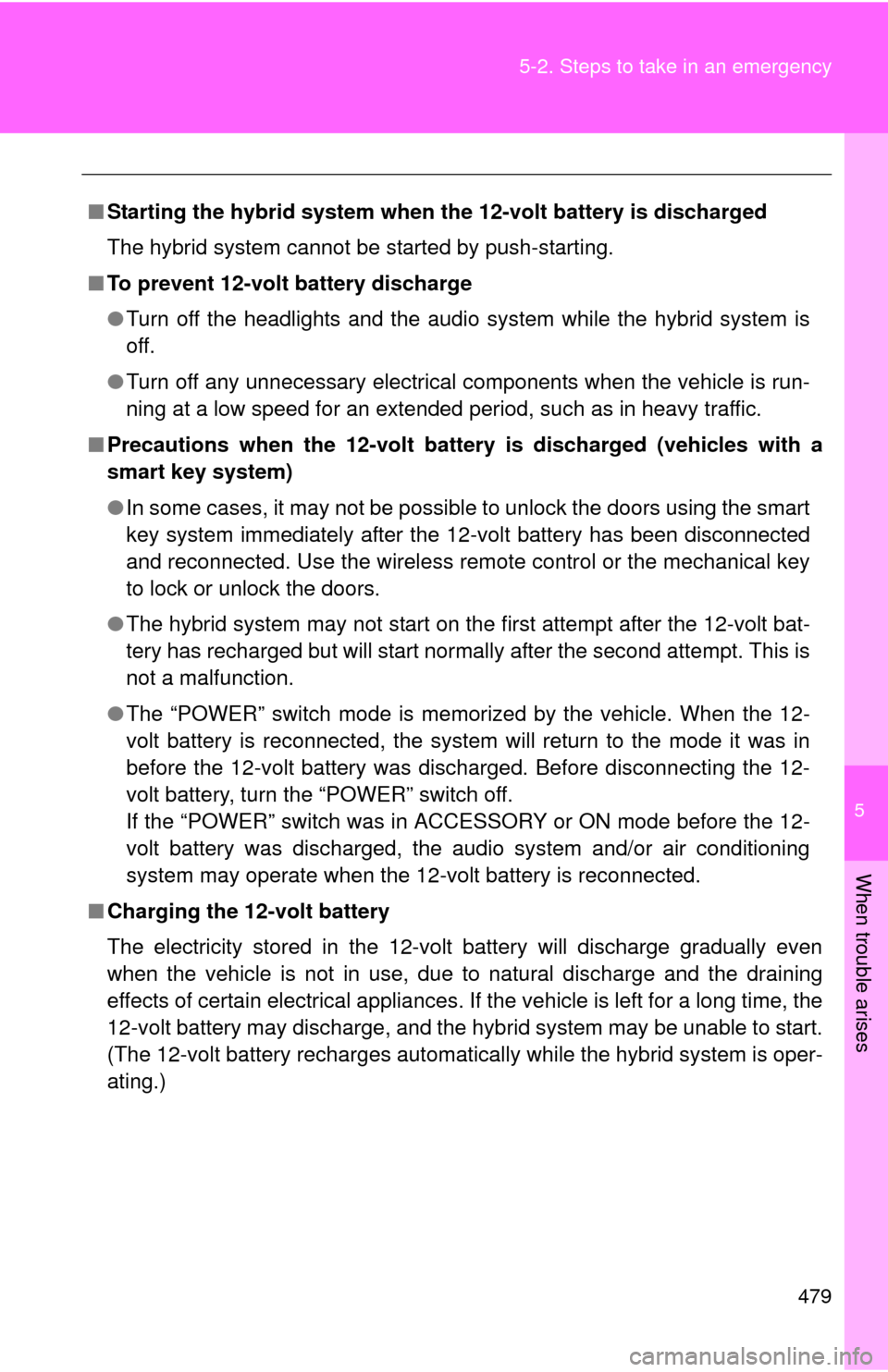
5
When trouble arises
479
5-2. Steps to take in an emergency
■
Starting the hybrid system when the 12-volt battery is discharged
The hybrid system cannot be started by push-starting.
■ To prevent 12-volt battery discharge
●Turn off the headlights and the audio system while the hybrid system is
off.
● Turn off any unnecessary electrical components when the vehicle is run-
ning at a low speed for an extended period, such as in heavy traffic.
■ Precautions when the 12-volt batter y is discharged (vehicles with a
smart key system)
● In some cases, it may not be possible to unlock the doors using the smart
key system immediately after the 12-volt battery has been disconnected
and reconnected. Use the wireless remote control or the mechanical key
to lock or unlock the doors.
● The hybrid system may not start on the first attempt after the 12-volt bat-
tery has recharged but will start normally after the second attempt. This is
not a malfunction.
● The “POWER” switch mode is memorized by the vehicle. When the 12-
volt battery is reconnected, the system will return to the mode it was in
before the 12-volt battery was discharged. Before disconnecting the 12-
volt battery, turn the “POWER” switch off.
If the “POWER” switch was in ACCESSORY or ON mode before the 12-
volt battery was discharged, the audio system and/or air conditioning
system may operate when the 12-volt battery is reconnected.
■ Charging the 12-volt battery
The electricity stored in the 12-volt battery will discharge gradually even
when the vehicle is not in use, due to natural discharge and the draining
effects of certain electrical appliances. If the vehicle is left for a long time, the
12-volt battery may discharge, and the hybrid system may be unable to start.
(The 12-volt battery recharges automatically while the hybrid system is oper-
ating.)
Page 480 of 556

480 5-2. Steps to take in an emergency
CAUTION
■Avoiding 12-volt battery fires or explosions
Observe the following precautions to prevent accidentally igniting the flam-
mable gas that may be emitted from the 12-volt battery:
●Make sure each jumper cable is connected to the correct terminal and that
it is not unintentionally in contact with anything other than the intended ter-
minal.
● Do not allow the other end of the jumper cable connected to the “+” termi-
nal to come into contact with any other parts or metal surfaces in the area,
such as brackets or unpainted metal.
● Do not allow the + and - clamps of the jumper cables to come into contact
with each other.
● Do not smoke, use matches, cigarette lighters or allow open flame near
the 12-volt battery.
■ After recharging the 12-volt battery
Have the 12-volt battery inspected at your Toyota dealer as soon as possi-
ble.
If the 12-volt battery is deteriorating, continued use may cause the 12-volt
battery to emit a malodorous gas, which may be detrimental to the health of
passengers.
■ When replacing the 12-volt battery
P. 381